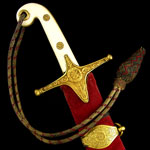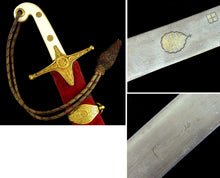Historic and Symbolic Sword Worn by The First Viceroy of India, Blade, circa 1840; hilt and scabbards circa 1856
Adding product to your cart
Blade length: 73.7cm (29ins)
The Sword of Charles John Canning, 1st Earl Canning, K.G., G.C.B., P.C. (1812-1862), First Viceroy of India, incorporating the Persian watered steel shamshir blade formerly in the possession of one of last of the ruling princes of Sind, fitted to an ivory mounted gilt-brass hilt of a British General Officer’s 1831 Pattern Mameluke Sabre, the blade inset with a gold-damascened lobed cartouche inscribed in Persian Arabic ‘bandeh-ye al-e mohammad shahdad’ (‘The servant of the family of Muhammad, Shahdad’); the blade further set with a talismanic square containing the letters B D W H for budduh, the guardian angel; the hilt cast and chased on each side with scrollwork, a laurel wreath, and British General Officer’s crossed sword and baton device, complete with bullion thread sword-knot, original red velvet-covered scabbard with gilt-brass mounts engraved with flowering foliage, and additional regulation brass field scabbard.
Provenance:
Charles John Canning (1812-1862), 1st Earl Canning, Viceroy of India (1858-62)
thence by bequest to his first cousin
Hubert George de Burgh-Canning, 2nd Marquess of Clanricarde (1832-1916)
thence by bequest to his great-nephew
Henry Lascelles, 6th Earl of Harewood (1882-1947)
George Lascelles, 7th Earl of Harewood (1923-2011)
The damascened blade inscription identifies it as belonging to Mir Shahdad Khan Talpur, one of the Baluchi chiefs, collectively known as the ‘Amirs of Sind’, who ruled the country’s 1.25 million inhabitants until annexation by the British in 1843.
Read more
Given the inauspicious date of Canning’s arrival in Calcutta, fifteen months before the mutiny of the Bengal Army and outbreak of the Great Rebellion of 1857-58, his acquisition of Mir Shahdad Khan Talpur’s sword, by whatever means, would have been a pertinent reminder of the difficulties of squaring the demands of diplomatic, political and military decisions with local rulers, the colonial administration in country and the home government. Central to the story of the Shahdad’s sword’s is the dispute between the British Resident in Sind and would-be pacifier Major (later Sir) James Outram, and the conqueror of Sind, General Sir Charles Napier of the Bombay Army; the difficult choices imposed on Shahdad, and the iniquity of his long time incarceration by the British at Calcutta.
Shahdad was the elder son of Mir Nur Muhammad Talpur, and was born about 1814 (1231) into the ruling house at Hyderabad. Following his father’s death in 1840 he fell into dispute with his younger brother Mir Hussein Ali Khan over the division of their father’s territories. The elder Amirs headed by Shahdad’s uncle Mir Muhammad Nasir tried to settle the dispute but without success, and at length the British Political Agent at Hyderabad, Major James Outram, and his interpreter, Lieutenant Eastwick, credited themselves with bringing about a resolution, whereby the brothers solemnly ratified an engagement in Kur’an binding themselves to keep the peace.
Sind itself had long been the subject of competing rivalries owing to the strategic positions of its ports. The Afghans conquered it in 1760 and thereafter claimed suzerainty over the Talpur princes of Baluchistan (or Amirs) whose occupation of the country they had abetted. Maharaja Ranjit Singh (‘Lion of the Punjab’) coveted it from his capital at Lahore as a Sikh outlet to the sea. The French had negotiated for it during and after the Napoleonic era, and the British desired it in order to open up the Indus for trade, and as a river route for rapid reinforcements to the frontier fortress of Ferozepore, lest Ranjit Singh or the ever apprehended Russians should strike. With respect to British trade, the embassy despatched by Lord Minto, the Governor General of India (1807-13), had negotiated a ‘Treaty of Eternal friendship’ with the Amirs in 1809. The Amirs had consequently closed the ports to the French and under the terms of a later treaty excluded the Americans from Sind also.
When Outram arrived at Hyderabad in February 1843 (1259) with yet another treaty still more favourable to the British, Mir Shahdad ‘wisely’ stood aloof while his uncle and numerous chiefs called for an assault on the British Residency. However, a letter sent by Muhammad Nasir to Karachi, ordering the destruction of the British and all in their employ, forced his hand - ‘because’, the letter said, ‘the English seem desirious of possessing themselves of our dominions. We are ourselves and three other Amirs, viz., Sobdar, Shahdad and Hussein Ali, have therefore determined upon taking the field forthwith.’ Added pressure also came from other Baluchis already moving against the Residency, imploring Shahdad to join them ‘in the name of family honour and the word of God’.
Accepting the self-evident provenence of the present blade it is well within the bounds of reason to suppose it was this that Shahdad fastened to his waist as he duly assembled his artillery on 15 February 1843 and used during the ensuing days of action. The attack on the Residency, directed by Shahdad, lasted four hours during which time Outram destroyed quantities of classified documents before fleeing with his escort and his dead by Indus river steamer to join Sir Charles Napier’s camp.
Outram’s suspicion that it had been Napier’s plan all along to use the new treaty to goad the Amirs into war was now confirmed as Shahdad joined his uncle Muhammad Nasir in camp at Miani. Knowing how the Amirs' undisciplined, ill-armed tribesmen would be slaughtered by Napier's army, Outram wrote to him protesting that his policies were harsh and tyrannical, and that every life lost in consequence would be murder. Outram once saluted by Napier as the ‘Bayard of India’, was now in correspondence at least, a ‘son of a bitch’.
Thus coerced Shahdad joined his uncle Muhammad Nasir and brother among the other Amirs encamped at Miani where battle was to be joined on 17 February with the force under Sir Charles Napier. Regrettably for the Talpur princes their army stood at about a third of its possible strength, as 8,000 men under Mir Sher Muhammad Talpur were unable to reach the battleground before the action commenced; and the Amir of Khairpur had been successfully bribed by Napier to stay away. The ensuing fight was marked by four or five hours of fearless Talpur cavalry charges against the disciplined musketry of the East India Company’s army. Despite 75% casualties the Talpur cavalry finally reached the British lines causing Napier himself to ride amongst his officers and men in order to stop them falling back in disarray before the day was won. Later when commenting on the slaughter, Napier told his brother 'the greatest scene of destruction I ever saw was the lane going up to Houguomont [at Waterloo in 1815] but I assure you it was nothing to the bed of the Fullailee [river] it was horrible.'
Next day the Baluchis requested an interview with Napier who demanded the unconditional surrender of Muhammad Nasir, Mir Shahdad and his brother Mir Hussein Ali Khan. Believing they had no practical alternative after the carnage of the previous day, Shahdad went with his brother and uncle to the British camp as requested, and unfastening their sword belts placed their blades before Napier. The British general, remembering the good treatment he had received from the French when left for dead after the Battle of Corunna in 1809, enacted his belief in 'a sound thrashing first and great kindness afterwards' by returning their swords and personally tying the same with his own hands on the waists of Shahdad and the other Amirs. It was an act, however, carried out without some regret, Napier musing afterwards 'the swords of nine dethroned princes surrendered on the field of battle would have been no trifling trophy in a private gentleman's family.'
While Mir Sher Muhammad Talpur remained at large to maintain maintain a 10-year guerilla war for Sind’s independence until finally accepting a pension from the British, the outcome for Shahdad and the Amirs of Hyderabad was one of great loss, their fort at Hyderabad being plundered, and they themselves exiled. Shahdad awaited the orders of the Governor General Lord Ellenborough and at length was sent to Surat, and, being kept separate from the other Amirs, was charged with setting fire to the British camp at Hyderabad and with the murder of Captain Ennis who was decapitated on banks of the Indus while getting into a boat at a time of heightened tensions. Despite Napier’s desire to hang Shahdad from the highest tower in Hyderabad, Outram’s protection and and Lord Dalhousie’s enquiry saw that he was acquitted, permitting him reside in Calcutta with the other Amirs, and to become, as the explorer Richard Burton put it, ‘the melancholy spectacle of fallen greatness.’
The Conquest of Sind was controversial in many respects, and the parliamentary debates that surrounded it would have been well known to Canning as Parliamentary Under-Secretary of State for Foreign Affairs in the Government of Sir Robert Peel. Later when Governor-General and facing the crisis of Rebellion he rose to the occasion against the expectation of many, exercising calm judgment and a prompt and swift hand. Yet his liberally-minded approach to the aftermath of the insurrection, contrasting strongly with vindictiveness of Napier, was the policy by which he became best known to history and by which the once derisive name of ‘Clemency Canning’ was turned into a title of honour.






